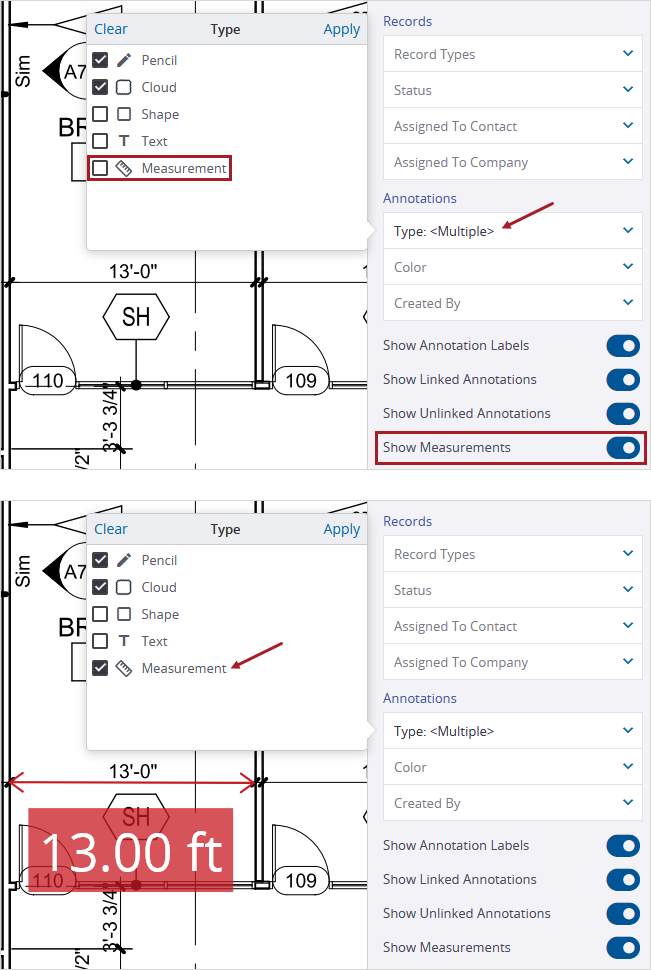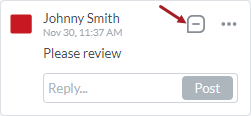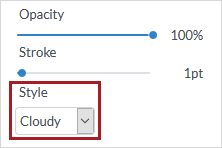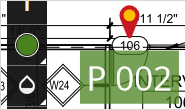Search tips
- To search in a subset of topics, select
 in the search field and select a filter.
in the search field and select a filter. - To search for a specific word or phrase, add quotation marks around it (example: "budget column") in the search field.
- To remove highlighting on the search terms in a topic, select
 .
. - To search within a topic, select
 , press Ctrl+F, and enter the search term.
, press Ctrl+F, and enter the search term.
You can add annotations for notes and for linking items to specific areas of a drawing. When you add an annotation, it's automatically private (visible only to you). However, you can make it public, so it's available for other people.
You add some text annotations to a drawing to capture some rough notes. Later you edit your notes and add some annotations that are linked to related files. Then you make the annotations public, so other project members can see them.
When a new revision is published, only the annotations from the most recent revision are included. If you add annotations to an old revision after a new one is published, they aren't copied to the current version.
- If the Layers panel is closed, select
(Layers) on the navigation toolbar.
- Ensure that the Show annotations toggle is on.
- To hide the public or private annotations, turn off the Show public annotations or Show private annotations toggle.
- In the Records section, filter the annotations based on linked records.
- Record types: The record types that you have access to.
- Status: The statuses for the record types that you have access to. This list is filtered based on the selected record types.
- Assigned to contact: The project contacts with open assignments for linked records that are unlocked.
- Assigned to company: The companies of the project contacts with open assignments for linked records that are unlocked.
- In the Annotations section, filter the annotations by their properties.
- Type: The annotation types.
- Color: The stroke and fill colors from the Annotation toolbar and Annotation menu. If the stroke and fill colors of an annotation are different, the annotation is displayed when you select either color.
- Created by: The users who added annotations that are visible to you. Your name is included even if you haven't added any annotations yet.
- To hide the labels for linked records, turn off the Show annotation labels toggle.
- To hide the linked or unlinked annotations, turn off the Show linked annotations or Show unlinked annotations toggle.
- To hide the measurement annotations, turn off the Show measurements toggle.
If you turn on the Show measurements toggle and the measurement annotations aren't showing, check the Type filter. To make the measurement annotations visible, make sure none of the types are selected, or select the Measurements checkbox.

- An annotation must meet all the selected filters to be visible in the drawing.
- If you select any filters in the Records section, any annotations that are unlinked or linked to other items such as drawings are hidden.
- The selected filters are applied as new annotations are added or linked records are updated. If an annotation disappears, you can select Remove applied filters to see all the annotations.
- All the items in the Links panel are available even when the linked annotations are hidden.
- The selected filters are still applied when you select
(Previous) or
(Next) to navigate to another drawing.
- At the bottom of the drawing, select Remove applied filters.
—Or—
In the Layers panel, select Reset filters.
The visibility of an annotation depends on who added the annotation, whether it's public or private, and what it's linked to. You can see an annotation if:
- It's an annotation that you added to the drawing.
- It's an unlinked public annotation.
- It's a public annotation that's linked to an item that you have access to.
- It's a photo annotation, which is always public.
In a drawing, you see the following annotations:
- A private annotation that you added and linked to a file.
- A public annotation that another user added and linked to an RFI that you have access to.
You don't see the following annotations:
- A private annotation that another user added.
- A public annotation that's linked to a draft record created by another user.
- Select the annotation.
- On the Annotation menu, turn the Public toggle on or off:
-
 (Public)
(Public) -
 (Private)
(Private)
If you don't have permission to create and modify public annotations, you can make your own annotations public by linking them to a record, specification, or specification set. To make the annotation private again, you can unlink the item.
The Annotation toolbar contains the tools for adding and styling annotations. For styling tools with multiple options, the button displays the most recently used one. When you select an annotation on the drawing, the toolbar displays the styling options that were used for it.
The selected styling options, such as the color and border width, apply to any new annotations that you add. You can also style the annotation after you add it.
| Default button | Name | Tool type | Description |
|---|---|---|---|
|
|
Pencil | Annotation | Draw a freehand line, straight line, or arrow. |
|
|
Cloud |
Annotation | Draw a cloud shape. |
|
|
Shape | Annotation | Draw a rectangle, circle, or polygon shape. |
|
|
Link | Annotation |
Add an annotation with a predefined shape that links to a record, drawing, or file. For more information about linking to annotations, see Links. |
|
|
Text | Annotation | Draw a text box, and enter the text. |
|
|
Photo | Annotation | Add a photo annotation, and link multiple photos and videos. |
|
|
Color | Styling |
Set the color for the text, stroke (line or border), and fill (background).
This tool doesn't apply to quick link annotations and photo annotations. |
|
|
Opacity | Styling |
For line annotations, set the opacity of the line. For cloud and shape annotations, set the opacity of the background fill color. |
|
|
Line width | Styling | Set the width for a line annotation or for the line around an annotation. |
|
|
Text size | Styling | Set the text size. |
|
|
Measurement | Annotation | Add a measurement annotation for the distance, perimeter, or area. |
After you add an annotation, you can edit it or link it to an item.
You can't copy and paste annotations.
- On the Annotation toolbar, select the styling tools.
- Select
 , and then select a tool.
, and then select a tool. - To draw the annotation, do one of the following:
-
 (Pencil) or
(Pencil) or  (Highlighter): Select the drawing and draw the line. There's a brief delay before the annotation is created so you can draw multiple lines.
(Highlighter): Select the drawing and draw the line. There's a brief delay before the annotation is created so you can draw multiple lines. -
 (Line) or
(Line) or  (Arrow): Select the drawing and draw the line. To adjust the line, select and move an endpoint.
(Arrow): Select the drawing and draw the line. To adjust the line, select and move an endpoint. -
 (Multi-point line):
(Multi-point line):  Draw the first line, and then add the connected lines.
Draw the first line, and then add the connected lines.
| Button | Name | Description |
|---|---|---|
|
|
Pencil | Freehand line |
|
|
Highlighter | Transparent freehand line |
|
|
Line | Straight line |
|
|
Arrow | Straight arrow |
|
|
Multi-point line | Series of connected straight lines |
To draw a straight line with a 0, 45, or 90 degree angle, press the Shift key as you draw the line, arrow, or multi-point line.
- On the Annotation toolbar, select the styling tools.
- Select
 or
or  , and then select a shape.
, and then select a shape. - To draw the annotation, do one of the following:
-
 (Cloud),
(Cloud),  (Rectangle), or
(Rectangle), or  (Circle): Select the drawing and move the pointer to draw the shape.
(Circle): Select the drawing and move the pointer to draw the shape. -
 (Custom cloud) or
(Custom cloud) or  (Custom shape):
(Custom shape):  Draw the first side, and then add the other sides.
Draw the first side, and then add the other sides.
| Button | Name | Description |
|---|---|---|
|
|
Cloud | Rectangular cloud |
|
|
Custom cloud | User-defined cloud |
|
|
Rectangle | Rectangular shape |
|
|
Circle | Round shape |
|
|
Custom shape | User-defined shape |
- On the Annotation toolbar, select
 , and then select an item type.
, and then select an item type. - You only see the item types that you have access to.
- If a record is linked, a label with the record type and number is displayed below the annotation.
 Record type abbreviations
Record type abbreviations
- I: Issues
- P: Punch items
- RFI: Requests for information
The abbreviations can also be changed in the nomenclature.
- If a new drawing revision is published, the new revision displays the link to the record. However, the record doesn't display a link to the new revision.
- To add a punch item annotation, select the drawing.
- Select the item to be linked.
| Button | Item type | Predefined shape |
|---|---|---|
|
|
RFI | Red cloud |
|
|
Issue | Blue rectangle |
|
|
Punch item | Red location pin (can't be resized or rotated)
The center color of the annotation matches the status of the linked record. |
|
|
Drawing | Blue circle |
|
|
Model view | Blue circle |
|
|
File | Blue circle |
—Or—
For the other annotations, select and draw the shape.
—Or—
For a record link annotation, create, copy, or select a record.
The Create and Copy options are only available if you have permission to create this record type.
- On the Annotation toolbar, select the styling tools.
- Select
 (Text).
(Text). - To draw the text box, select the drawing and move the pointer.
- Double-click the text box, and then type the text.
- To finish, select outside of the text box.
- On the Annotation toolbar, select
 (Photo).
(Photo). - To place the photo annotation on the drawing, select the drawing.
- On the Annotation menu, select Upload from computer.
- Browse to and select one or more photos or videos from your computer.
- The supported image types are .bmp, .heic, .heif, .jpeg, .jpg, .png, .tif, and .tiff. After you upload .heic or. .heif files, they are converted to .jpeg files.
- The supported video types are .mov, .mp4, and .webm.
- After you save the drawing, the linked photos are available in the Photos module, and the linked videos are available in the file management system.
- If you don't link any photos or videos to the photo annotation, the annotation is deleted automatically when you save the drawing.
- If the calibration isn't set yet, calibrate the drawing.
- Draw the measurement.
- Edit the scale for the measurement.
- Link an item to the measurement.
You can add notes and replies to annotations.
- On the toolbar, select
 (Comments).
(Comments).
- In the Comments panel, select Filter, and then select the filters.
- Select Apply.
- In the Comments panel, select an option:
- Position: Sort the notes by the order (top to bottom) that they appear in the drawing.
- Created Date: Sort the notes by the date that they were created.
- Modified Date: Sort the notes and replies by the time that they were modified.
- Status: Sort the notes by the status.
- Author: Sort the notes the author's name.
- Type: Sort the notes by the annotation type.
- Color: Sort the notes by the annotation color.
- In the drawing, select an annotation.
- On the toolbar, select
 (Comments).
(Comments). - In the Comments panel, enter a note for the selected annotation.
- In the Comments panel, select the note.
- At the top-right of the note, select the status icon, and then select a status.

- In the Comments panel, select the note.
- Enter your comment in the reply field, and then select
 (Post).
(Post).
- In the Comments panel, select the note.
- In your reply, select
 > Edit or Delete.
> Edit or Delete. - You can only edit but not delete the first note of an annotation.
- If you have permission to add and modify notes and replies for public annotations, you can edit the first note that you or another user added. Otherwise, you can only edit the first note that you added.
- You can only edit and delete your own replies to the first note of an annotation.
You can edit public annotations, if you have permission to do so, and your own annotations.
- For punch item annotations, the selected annotation color only affects the record label.
- By default, callout annotations don't have a border or fill. You can select (Line / Border Size) or
 (Fill Opacity) on the Annotation toolbar to add them.
(Fill Opacity) on the Annotation toolbar to add them.
- Select the annotation.
- On the Annotation menu, select
(Style).
- On the Annotation menu, select
 (Style).
(Style). - Do any of the following:
- To change the color of an annotation, select a color. Depending on the type of annotation, you can select a color on the Text, Stroke and Fill tabs.
- Depending on the type of annotation, you can set options in different sections, such as Text Style.
- To adjust the opacity of an annotation, select and move the Opacity slider.
- To adjust the stroke width of a line annotation, select and move the Stroke slider.
- To adjust the text of an annotation, modify the options on the Text tab.
- To change the line style of a shape annotation, select an option from the Style list.

Style tabs that may be available for an annotation

- Select the annotation.
- To move the annotation, select and drag the middle of it.
- To resize the annotation, select and drag a sizing handle.

If a large annotation overlaps with a smaller annotation, the smaller annotation is selected when you click the annotation area. To select the larger annotation, click an area that doesn't overlap with the smaller annotation.
- Select and drag the annotation label.
If you move the annotation, the label remains in the same place.
If the annotation and its label overlap, select the text of the label to move it.
You can delete public annotations, if you have permission to do so, and your own annotations.
- If you delete a photo annotation, the linked photos remain available in the Photos area, and the linked videos remain available in the file management system.
- If you remove all the photos and videos that are linked to a photo annotation, the annotation is deleted when you save the drawing.
- Select the annotation.
- On the Annotation menu, select
(Delete).
—Or—
Press the Delete key.



